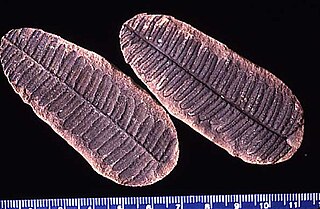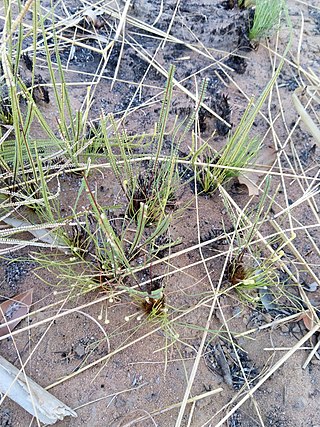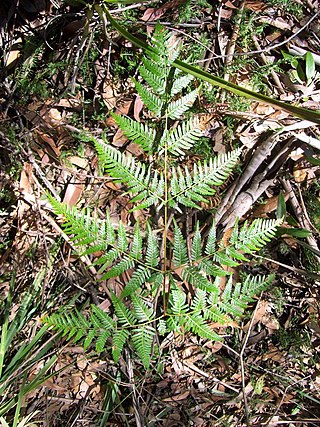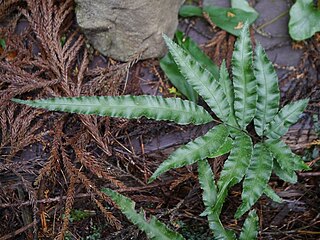
Pteris (brake) is a genus of about 300 species of ferns in the subfamily Pteridoideae of the family Pteridaceae. They are native to tropical and subtropical regions, southward to New Zealand, Australia, and South Africa, north to Japan and North America. 78 species are found in China. Some species of Pteris have considerable economic and ecological value, such as Pteris multifida, Pteris ensiformis, Pteris vittata can be used for ornamental purposes; as a hyperaccumulator, Pteris multifida and Pteris vittata can be used to control soil pollution.

Matteuccia is a genus of ferns with one species: Matteuccia struthiopteris. The species epithet struthiopteris comes from Ancient Greek words στρουθίων (strouthíōn) "ostrich" and πτερίς (pterís) "fern", so named for the large spore bearing structures resembling ostrich feathers.

Pteridaceae is a family of ferns in the order Polypodiales, including some 1150 known species in ca 45 genera, divided over five subfamilies. The family includes four groups of genera that are sometimes recognized as separate families: the adiantoid, cheilanthoid, pteridoid, and hemionitidoid ferns. Relationships among these groups remain unclear, and although some recent genetic analyses of the Pteridales suggest that neither the family Pteridaceae nor the major groups within it are all monophyletic, as yet these analyses are insufficiently comprehensive and robust to provide good support for a revision of the order at the family level.

Pteris vittata, commonly known variously as the Chinese brake, Chinese ladder brake, or simply ladder brake, is a fern species in the Pteridoideae subfamily of the Pteridaceae. It is indigenous to Asia, southern Europe, tropical Africa and Australia. The type specimen was collected in China by Pehr Osbeck.

Pecopteris is a very common form genus of leaves. Most Pecopteris leaves and fronds are associated with the marattialean tree fern Psaronius. However, Pecopteris-type foliage also is borne on several filicalean ferns, and at least one seed fern. Pecopteris first appeared in the Devonian period, but flourished in the Carboniferous, especially the Pennsylvanian. Plants bearing these leaves became extinct in the Permian period, due to swamps disappearing and temperatures on Earth dropping.

Pteris platyzomopsis, synonym Platyzoma microphyllum, is a fern in the family Pteridaceae. When placed in the genus Platyzoma, it was the only species; the genus was sometimes placed in its own family, Platyzomaceae. The species is native to northern Australia, occurring in the Kimberley region of Western Australia, in the Northern Territory and Queensland, and in northern New South Wales, where it is considered endangered. Vernacular names include braid fern.
P. linearis may refer to:

Selaginella umbrosa is a species of plant in the Selaginellaceae family.

Pteridium esculentum, commonly known as bracken fern, Austral bracken or simply bracken, is a species of the bracken genus native to a number of countries in the Southern Hemisphere. Esculentum means edible. First described as Pteris esculenta by German botanist Georg Forster in 1786, it gained its current binomial name in 1908. The Eora people of the Sydney region knew it as gurgi.

Pteris tremula, commonly known as Australian brake, tender brake, tender brakefern, shaking brake is a fern species of the family Pteridaceae native to sheltered areas and forests in eastern Australia and New Zealand. It has pale green, lacy fronds of up to 2 meters in length, with an erect, tufted rhizome that is covered with narrow brown scales. It is fast-growing and easy to grow in cultivation, but can become weedy.

Diplazium molokaiense is a rare species of fern known by the common name Molokai twinsorus fern. It is endemic to Hawaii, where it is one of the rarest ferns. It has historically been found on the islands of Kauai, Oahu, Lanai, Molokai, and Maui, but it is thought to have been extirpated from four of them and today can be found only on Maui where fewer than 70 individual plants remain. The fern was federally listed as an endangered species of the United States in 1994.

Pteris ensiformis, the slender brake, silver lace fern, sword brake fern, or slender brake fern, is a plant species of the genus Pteris in the family Pteridaceae. It is found in Asia and the Pacific.
Pteris lydgatei is a rare fern species in the Pteridoideae subfamily of the Pteridaceae. It is known by the common name Lydgate's brake and is endemic to Hawaii, where it is known from the islands of Oʻahu, Molokaʻi, and Maui. It was once thought to be extinct until it was rediscovered in the 1990s. There are fewer than 40 individuals in the wild. This is a federally listed endangered species of the United States.
Pteris longifolia, the longleaf brake is a species of fern in the Pteridoideae subfamily of the Pteridaceae.

Pteris comans is a fern from eastern Australia and New Zealand. The habitat of the hairy bracken or netted brake is rainforest or moist open forest. The botanist Johann Georg Adam Forster published this plant in Halle, the year 1786, in his Florulae Insularum Australium Prodromus. The specific epithet comans is derived from Latin, meaning "covered with hair".

Pteris cretica, the Cretan brake, ribbon fern, or Cretan brake fern, is a species of evergreen fern in the family Pteridaceae, native to Europe, Asia and Africa.

Pteris biaurita, the thinleaf brake, is a fern species in the genus Pteris. It is widely distributed around the world, including Africa, the Americas, and Asia. The plants are 70–110 cm in height, with erect, woody rhizomes 2–2.5 cm in diameter, and the apex densely covered with brown scales.

Pteris parkeri, the silver ribbon fern, is a species of evergreen fern in the family Pteridaceae, native to Japan, Taiwan and Korea.














